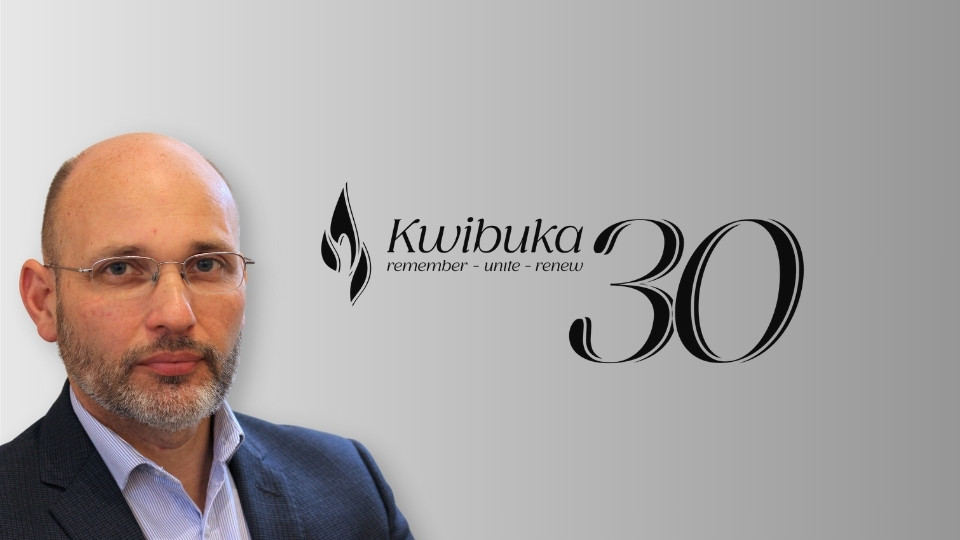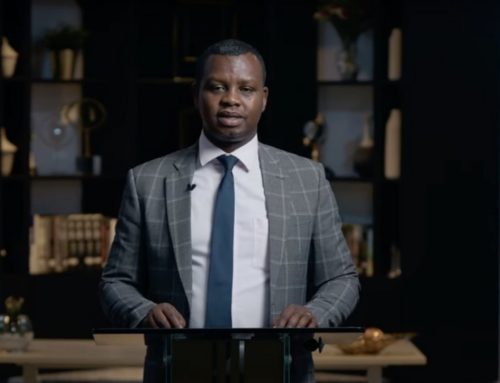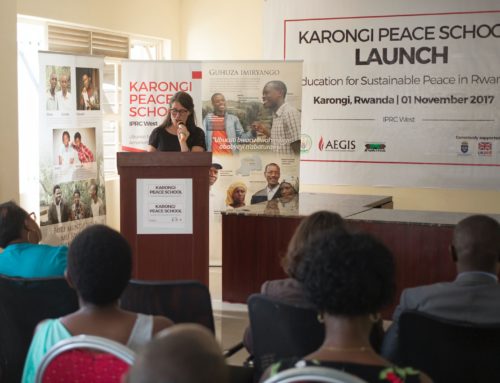Addressing a Kwibuka 30 event at the FCDO in London on 25 April 2024 marking 30 years since the Genocide against the Tutsi, Aegis Founder Dr James Smith explored the nature and enduring impact of the roots it shares with the Holocaust.
Tracing contemporary genocidal ideologies to 19th and early 20th-century racial theories, Smith noted that “European and American anthropologists were obsessed with race, one motivation being to give an air of scientific credibility to the racial prejudice which underpinned colonialism.” He highlighted how these theories marked both Jews and Tutsis as outsiders, leading to dehumanization and violence.
The speech also addressed the ongoing dangers of denial and revisionism. Smith explained how “double genocide” narratives attempt to reframe both the Holocaust and the Genocide against the Tutsi as conflicts between two sides. This, he noted, “diminishes the gravity of Nazi crimes and the role played by racist ideology” in the Holocaust, and similarly deflects blame from the perpetrators in Rwanda. Smith warned that such revisionism “adds to the injury felt by survivors” and continues to fuel dangerous ideologies today, not least in eastern DRC.
Despite these challenges, Smith concluded on a hopeful note, praising Rwanda’s journey towards peace and reconciliation. He emphasized the power of education, particularly the Peace and Values Education programme which was first developed by the Aegis Trust at the Kigali Genocide Memorial. “There is much that the World can learn, that the World desperately needs to learn, from Rwanda’s extraordinary example of peace and reconciliation,” he said. “If peace can be built in Rwanda, it can be built anywhere.”
FULL TEXT OF THE SPEECH FOLLOWS.
James Smith
Kwibuka 30
FCDO, London
25 April 2024
In 1994, my brother Stephen and I were a year out from opening the UK National Holocaust Museum when the Genocide against the Tutsi occurred across Rwanda.
Along with the genocide at Srebrenica in Bosnia in 1995, it gave us pause. How could we honour the memory of victims of the Holocaust unless responding in some way to the horrific identity-based violence in the present?
Establishing the Aegis Trust to respond to that challenge, as medical doctor, my aim was to apply the public health model to genocide prevention. To draw a medical analogy, just as different cancers have specific characteristics, there are also patterns that help us to understand what is going wrong and therefore how to prevent and treat. In the same way, each genocide is specific, but there are also patterns that may help us understand how to prevent.
Despite differing geo-politics, the parallels between the Holocaust and the Genocide against the Tutsi were greater than I had imagined. Even the ideas which underpinned these genocides had a common root.
19th and early 20th Century European and American anthropologists were obsessed with race, one motivation being to give an air of scientific credibility to the racial prejudice which underpinned colonialism – and the slavery that preceded it.
I was struck to find the same photographs of Europeans recording shapes of faces and craniums of people in 1930s in Rwanda, at the very same time they were dividing people into a hierarchy of races in Europe.
One early myth of anthropologists describes Jews as being descendants of Shem, a son of the biblical Noah, calling them Semites. We still use this mythical racial construct in the term anti-Semitism for anti-Jewish hate. The myth of the Semite established Jews as outsiders who did not belong in Europe.
The same racial theorists postulated that Tutsi in Rwanda were descendants of another son of Noah, Ham. They called the Tutsi Hamites, suggesting they came from Abyssinia or Ethiopia. This led to them being considered as outsiders or interlopers who did not belong in Rwanda.
For both Jews and Tutsis, dehumanisation flowed from these racial theories.
It’s a short step from being marked as outsiders to being labelled as a threat.
In both cases hate media propagated conspiracy theories. Across Europe the idea of the ‘wandering, controlling Jew’ developed and informed Nazi ideology, being used to justify the mass murder of six million Jews in the Holocaust.
In Rwanda the colonial Hamitic myth gave rise to the idea that Tutsis are constantly in pursuit of the Hamitic Tutsi-Hima kingdom. It became basis for a genocidal ideology against them and is why tens of thousands of Tutsis were thrown into the rivers in 1994, to send them on a ‘short cut home’ via the River Nile to Ethiopia.
This is not consigned to history. Conspiracy theories continue to circulate – identifying both Jews and Tutsis a threat, bent on domination through business, banks, the media and politics. These ideas led to incitement to violence and murder in the past and will do so again. Indeed, the idea that Congolese Tutsi do not belong in their Eastern Congo homeland, and are part of a wider conspiracy of Tutsi control, persists and is leading to violence as we speak.
Warning signs were also present before the Genocide against the Tutsi, as they were ahead of the Holocaust. In both cases, with a handful of noble exceptions, the World failed to take heed or care, until it was too late.
The result: as we will soon hear from Antoinette Mutabazi, survivors, often with almost their entire families murdered, were left to pick up the broken pieces of their lives.
After both the Holocaust and the Genocide against the Tutsi ended, the patterns continue. Denial and revisionism add to the injury felt by survivors.
Consider Holocaust memory. Jews were blamed by Nazis for communism, pointing to some Jews who saw communism as the antidote to the scourge of antisemitism. Holocaust museums often display anti-communist propaganda as part of the context. However in the decades after the Holocaust it became popular in some European States to say that Jewish Bolsheviks committed atrocities first, which led the Nazis to plan the extermination of the Jews. They add that nationalist collaborators of the Nazis in eastern Europe joined in the killing sprees because they were angry with the Jews for communism. The Holocaust was relativised into a conflict of two sides, both of which committed atrocities. This ‘double genocide’ narrative diminishes the gravity of Nazi crimes and the role played by racist ideology. It also deflects blame from perpetrators, implying Jews brought the Holocaust on themselves.
Likewise, we now see a revisionist assertion, including in British media, framing the context that a Tutsi led-Rwandan Patriotic Front committed ethnic cleansing before the genocide against the Tutsis. Leaving aside the veracity of this claim, it follows the same narrative arc of double genocide theory as in relation to the Holocaust. The effect is to transfer blame from the genocidal Hutu government onto the victims of genocide, implying Tutsis were architects of their own destruction.
I end on a positive note. Genocide shows us the worst of humanity. It also shows us the best. In both the Holocaust and the Genocide against the Tutsi, heroes risked their lives to save friends, neighbours and even complete strangers. For example, ten-year-old Hutu girl Grace, who was prepared to die to save a Tutsi baby she called Vanessa. Peace and Values Education was developed by an Aegis Trust team of survivors at the Kigali Genocide Memorial. It is built around the true stories of these remarkable Rwandan heroes.
Now integrated into Rwanda’s national schools curriculum, it has enabled young Rwandans to face the reality of the past. Peace and values education enables them to debunk racial theories, reject conspiracy theories and in some cases give up plans for armed violence.
It’s been a privilege for me over two decades to observe how people who should have been torn apart by the legacy of genocide have chosen instead to build stable, peaceful communities together. There is much that the World can learn, that the World desperately needs to learn, from Rwanda’s extraordinary example of peace and reconciliation. If peace can be built in Rwanda, it can be built anywhere.
Thank you.



